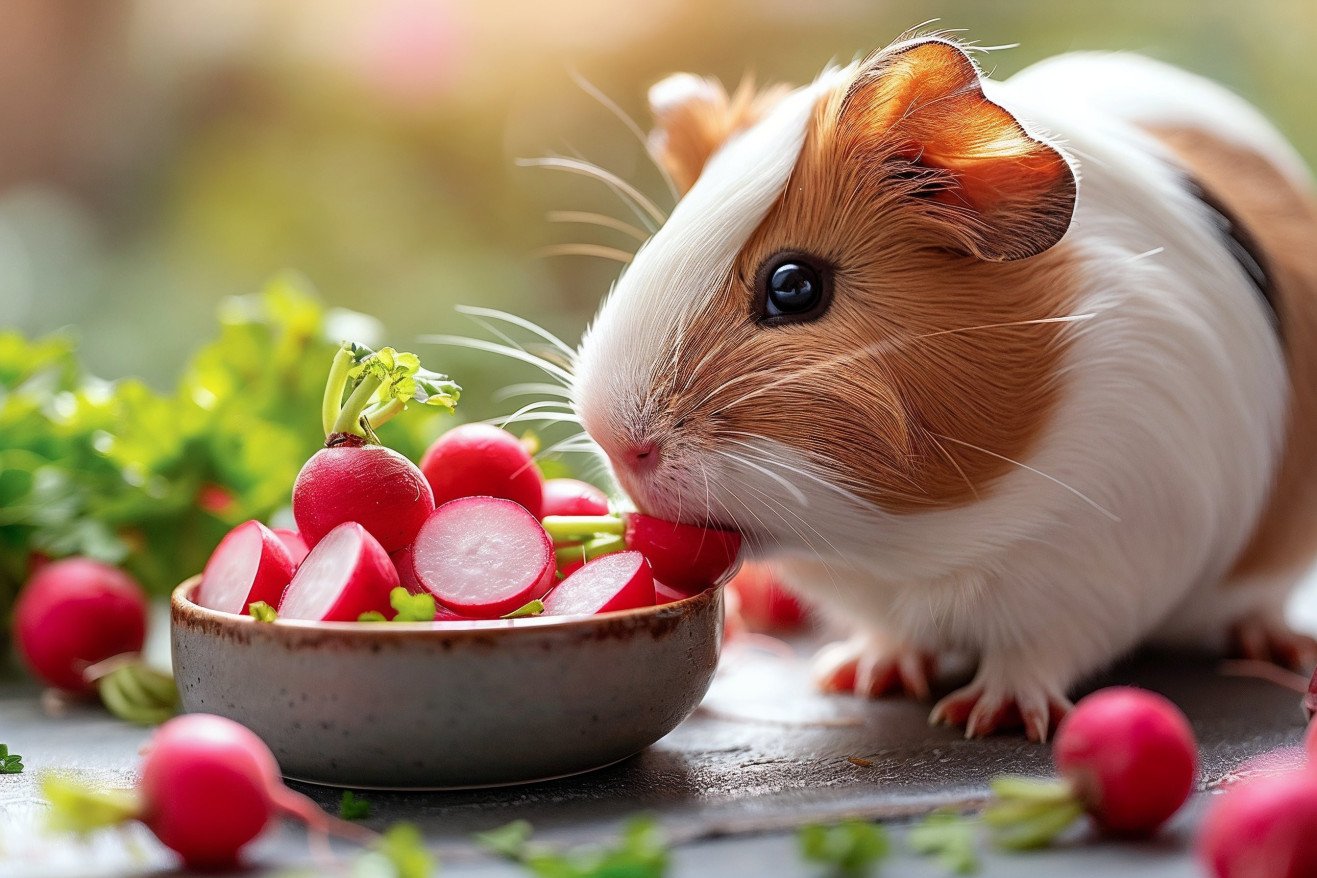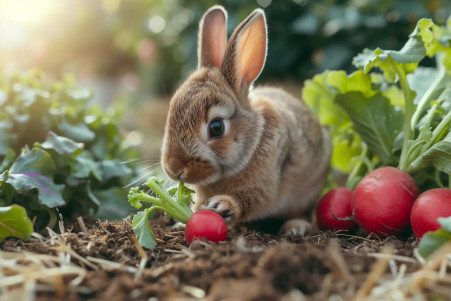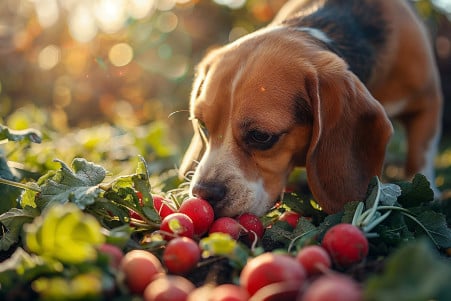Can Guinea Pigs Eat Radishes? Safe Portions & Risks Explained
11 February 2024 • Updated 10 February 2024

Radishes are a crunchy, slightly spicy root vegetable that many people enjoy, but are they safe for guinea pigs to eat? The answer is yes, guinea pigs can eat radishes, including the skin and the greens, but only in moderation.
To prevent health problems like urinary stones that can be caused by the calcium and sodium in radishes, you can give them to your guinea pig as an occasional treat, ideally no more than once or twice a week and in small servings.
To help you better understand the role radishes can play in your guinea pig’s diet, we’ll take a closer look at what the experts have to say and break down the nutritional content of radishes.
By considering advice from veterinarians, learning more about how guinea pigs’ digestive systems work, and taking a closer look at what radishes have to offer, we’ll be able to come up with some general recommendations for how you can safely add radishes to your guinea pig’s diet.
This way, you’ll be better equipped to make sure you’re feeding your guinea pig in a way that supports their overall health and happiness.
Can guinea pigs eat radishes?
Nutritional Benefits: What Radishes Can Do for Your Guinea Pig
In addition to their texture, radishes are also full of nutrients that can help your guinea pig. Healthline notes that radishes are high in vitamin C, which is important for guinea pigs since they can’t produce it themselves. This vitamin helps to boost their immune system and prevent diseases like scurvy.
Meanwhile, Verywell Fit explains that radishes have almost 2 grams of fiber per cup, which can help with digestion and ensure that your pet can properly process the fibrous plants they eat.
The antioxidants in radishes also help to ensure that they’re getting the most out of their food, as they help to combat free radicals in the body and can even help reduce the risk of chronic diseases. Plus, WebMD adds that radishes are also high in vitamins and minerals like calcium, potassium, and iron, which are all important parts of a guinea pig’s diet.
That said, it’s important to note that while radishes have a lot of benefits, they should only be a small part of a guinea pig’s diet. Instead, guinea pig owners should make sure to give their pets a mix of hay, fresh grass, and a variety of leafy greens to ensure that they get all of the nutrients they need.
Plus, it’s important to make sure that radishes are only given in moderation. They should be used as an occasional treat that’s given in addition to a guinea pig’s regular diet to ensure that they’re getting the nutrients they need.
Guinea Pig Digestive System
Guinea pigs have a unique digestive system that has evolved to enable them to effectively process a diet that is high in fiber. This is because, as Supreme Petfoods notes, their large intestine contains a structure called the caecum, which is full of beneficial bacteria that can ferment the fiber in their food.
This fermentation process enables guinea pigs to extract the maximum amount of nutrition from their food, especially from foods that they eat over and over again, like ‘caecotrophs’—pellets that their bodies produce that are full of nutrients.
This is especially important when it comes to vitamin C, which guinea pigs can’t produce on their own. As a result, it’s essential that pet parents make sure that their guinea pigs are getting the right nutrients to avoid scurvy, a potentially fatal condition that’s caused by a lack of vitamin C.
It’s important to know what a healthy digestive system looks like in guinea pigs. Signs that everything is working as it should include regular eating, normal fecal output, and the regular consumption of caecotrophs.
On the other hand, signs that a guinea pig may be having digestive issues include diarrhea, a lack of appetite, and not eating caecotrophs. If any of these symptoms occur, Supreme Petfoods recommends that pet parents take their guinea pigs to the vet as soon as possible.
In order to keep your guinea pig’s digestive system healthy, make sure that they have a constant supply of hay and vegetables that are high in vitamin C, and pay close attention to how they’re eating and how their body is responding to their diet. This will help ensure that while healthy treats like radishes can be enjoyed, they’re eaten safely and in moderation.
The Bottom Line: How to Safely Feed Radishes to Guinea Pigs
Radishes can be a healthy addition to guinea pigs’ diets, but they also pose some risks that need to be managed. dvm360 warns that guinea pigs that eat too many radishes can be at a higher risk of developing urinary stones because of the vegetables’ high calcium and sodium content.
This is especially problematic for guinea pigs because they have a unique way of processing calcium, which can lead to the formation of calcium oxalate precipitates in their urine.
Oxalates, which are present in radishes, can make the risk of renal problems even worse. A study on PubMed explains that guinea pigs that eat large amounts of oxalate-containing plants can develop renal failure, which is characterized by symptoms like anorexia and weight loss.
The Guinea Pig Vet also recommends that owners consider the calcium-to-phosphorus ratio in their guinea pigs’ diet and avoid giving high doses of Vitamin C to guinea pigs that are prone to calcium oxalate stones.
To avoid these health problems, guinea pig owners should give their pets radishes in small amounts and no more than twice a week. They should also monitor their guinea pigs for signs of dietary issues, including changes in their urination habits, lethargy, and a hunched posture, which can be a sign of urinary issues. By doing this, guinea pig owners can make sure that radishes are a positive addition to their pets’ diets.
Radishes in a Healthy Guinea Pig Diet
The RSPCA’s recommended diet for guinea pigs includes unlimited access to fresh grass, high-quality hay, and a selection of fresh, washed leafy greens like kale or broccoli. Not only are these foods important for digestion, but they also help ensure that guinea pigs get enough vitamin C.
In this context, radishes can be a nice addition to the diet, providing a little variety and an extra vitamin boost every once in a while, but they shouldn’t be a regular part of the diet.
VCA Animal Hospitals recommends supplementing the guinea pig diet’s fiber-rich base with colorful vegetables like bell peppers and tomatoes, which are both good sources of vitamin C. Similarly, small amounts of radishes can be added to these vitamin-rich vegetables to help ensure that your guinea pig’s diet is as varied and interesting as possible.
FOUR PAWS International also notes the importance of variety, and in addition to the RSPCA’s recommended vegetables, they include carrots, cucumbers, and zucchini as safe options.
When you introduce radishes, do so slowly to give your guinea pig’s digestive system time to adjust. Start with a small piece and watch your guinea pig closely to see how they react, paying special attention to any changes in behavior or droppings that could indicate digestive problems.
With this kind of careful observation, radishes can be a fun, occasional part of the mix of fresh foods that make up a healthy diet for your guinea pig.
Conclusion: How to Incorporate Radishes into Your Guinea Pig’s Diet
To sum up, radishes can be a healthy addition to your guinea pig’s diet if they are fed in moderation. They contain vitamin C, which is important for guinea pigs, and fiber, which can help with their unique digestive systems.
However, they also contain calcium and oxalates, which can lead to health problems like urinary stones and kidney issues if they are overconsumed. This is why it’s important to make sure that radishes are part of a well-rounded diet that includes other vegetables as well as plenty of hay and leafy greens.
As a responsible pet owner, it’s also important to pay attention to how your guinea pig reacts to new foods. This means watching their behavior and physical reactions to radishes as you slowly and gradually introduce them to your pet in small amounts. This will help ensure that your guinea pig gets the nutritional benefits of radishes while minimizing any potential problems.
This article can help you make sure that you are feeding your guinea pig radishes in a way that supports their overall health and well-being. By following these tips, you can confidently introduce radishes to your guinea pig and make sure that they are getting a diverse and nutritious diet.


